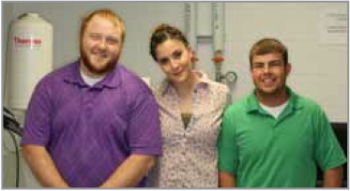Materials Science
Projects
For 2013, the four teams are conducting the following failure analysis investigations:
Team ‘Merica: Analysis of the Failure of an HV Segment
This failure analysis was conducted to determine the technical causes of failure of a fractured HV segment. The HV segment is used as a height adjuster in the seat assembly of many automotive vehicles. In addition, during an automotive accident, the HV segment acts
as a safety device, preventing the driver and passenger seats from moving in a way that would injure the occupants of the vehicle. During quality testing of the HV segment, it fractured at a lower load than the industry standards require. The purpose of this failure analysis is to determine the failure mode and causes of the failure of the HV segment. By collecting background information and photographs, performing visual examinations, and implementing non-destructive and destructive testing techniques, the causes of the failure of the HV segment were determined.
Team Espana: Clevis D-ring Failure Investigation
A Clevis D-ring made out of steel failed when the component was put under load of around 3330 pounds. The failure in this case, fortunately, did not result in any major economic or personal losses. These D-rings are used in many other aspects in the world such as tie downs on trucks and they are used for lifting. In our report we will include background data about the failed component and what was happening when the component failed. For that we are doing various testing techniques, both nondestructive (such as SEM, macrophotography, replica testing, and computerized stress analysis) and destructive (cleaning with acids, stress analysis), that will help us to find the cause of failure.
Team Won: Fracture Analysis of the Failed Lower Link of a Motorcycle
The lower link for a Yamaha YZ–R1 motorcycle failed during a rider’s routine, leisurely cruise. Potential loss of life was averted as the rider was able to halt the motorcycle and safely dismount. The lower link was removed and brought before a team of senior materials engineering students (Team Won) to investigate and analyze the circumstances of the failure. After due deliberation, the group selected from a variety of nondestructive testing methods and devised an appropriate plan to evaluate the failed lower link, in hopes of discovering the cause of failure and applying the knowledge gained toward prevention of any future incidents under equivalent circumstances.
Team Triple Threat: Failure Analysis of an Air Cooled Turbine Blade
The purpose of this project was to analyze an air cooled turbine blade of a Co-based alloy with an aluminide coating that failed under normal use. X-40 cobalt-based alloy exhibits excellent corrosion and oxidation resistance, and is therefore commonly used in jet engine turbines. The failure of this component was discovered when a jet engine began to malfunction, and a thorough inspection of the unit was completed. A failure such as this is potentially fatal and must be addressed to ensure the safe design of future turbine blades. Through non-destructive and destructive testing and analysis the group will determine the modes of failure and construct a preventative maintenance or design plan.



